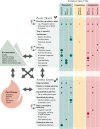The influence of changing fire regimes on specialized plant-animal interactions
- PMID: 40241458
- PMCID: PMC12004102
- DOI: 10.1098/rstb.2023.0448
The influence of changing fire regimes on specialized plant-animal interactions
Abstract
Ecological effects of changing fire regimes are well documented for plant and animal populations, but less is known about how fire influences, and is influenced by, specialized plant-animal interactions. In this review, we identified mutualistic (pollination, seed dispersal and food provision), commensal (habitat provision) and antagonistic (seed predation, herbivory and parasitism) plant-animal interactions from fire-prone ecosystems. We focused on specialized interactions where a single genus depended on one to two genera in a single family of plant or animal. We categorized the plant partner's post-fire reproductive mode to assess the likely outcome of changing fire regimes on ecological functions provided by these interactions. Traits underlying specialization in fire-prone ecosystems for plants were: post-fire reproductive mode, time to maturity, morphology and phenology; and, for animals: dispersal, specialized organs, nesting and egg deposition substrates, plant consumption behaviours and pollinator behaviours. Finally, we identified a number of cases where stabilizing feedbacks maintained plant-animal interactions under natural fire regimes. Potential reinforcing feedbacks were also identified, but were more likely to happen abruptly and result in collapse of the plant-animal partnership, or partner switching. Our synthesis reveals how fire regime changes impact fire-dependent specialist plant-animal interactions and potentially drive eco-evolutionary dynamics in fire-prone ecosystems globally.This article is part of the theme issue 'Novel fire regimes under climate changes and human influences: impacts, ecosystem responses and feedbacks'.
Keywords: ecological specialization; evolutionary ecology; feedback; fire ecology; global change; niche breadth.
Conflict of interest statement
We declare we have no competing interests.
Figures

Similar articles
-
Novel wildfire regimes under climate change and human activity: patterns, driving mechanisms and ecological impacts.Philos Trans R Soc Lond B Biol Sci. 2025 Apr;380(1924):20230446. doi: 10.1098/rstb.2023.0446. Epub 2025 Apr 17. Philos Trans R Soc Lond B Biol Sci. 2025. PMID: 40241461 Free PMC article. Review.
-
Pyrodiversity begets plant-pollinator community diversity.Glob Chang Biol. 2016 May;22(5):1794-808. doi: 10.1111/gcb.13236. Epub 2016 Feb 29. Glob Chang Biol. 2016. PMID: 26929389
-
The fire regimes of the Cerrado and their changes through time.Philos Trans R Soc Lond B Biol Sci. 2025 Apr;380(1924):20230460. doi: 10.1098/rstb.2023.0460. Epub 2025 Apr 17. Philos Trans R Soc Lond B Biol Sci. 2025. PMID: 40241456 Free PMC article.
-
Priority research directions for wildfire science: views from a historically fire-prone and an emerging fire-prone country.Philos Trans R Soc Lond B Biol Sci. 2025 Apr;380(1924):20240001. doi: 10.1098/rstb.2024.0001. Epub 2025 Apr 17. Philos Trans R Soc Lond B Biol Sci. 2025. PMID: 40241447 Free PMC article.
-
Pyrodiversity is the coupling of biodiversity and fire regimes in food webs.Philos Trans R Soc Lond B Biol Sci. 2016 Jun 5;371(1696):20150169. doi: 10.1098/rstb.2015.0169. Philos Trans R Soc Lond B Biol Sci. 2016. PMID: 27216526 Free PMC article. Review.
Cited by
-
Hidden influence of fire on locally rare and cryptic reptile species.Ecology. 2025 Jun;106(6):e70121. doi: 10.1002/ecy.70121. Ecology. 2025. PMID: 40544360 Free PMC article.
-
Novel wildfire regimes under climate change and human activity: patterns, driving mechanisms and ecological impacts.Philos Trans R Soc Lond B Biol Sci. 2025 Apr;380(1924):20230446. doi: 10.1098/rstb.2023.0446. Epub 2025 Apr 17. Philos Trans R Soc Lond B Biol Sci. 2025. PMID: 40241461 Free PMC article. Review.
References
-
- Carbone LM, Tavella J, Pausas JG, Aguilar R. 2019. A global synthesis of fire effects on pollinators. Glob. Ecol. Biogeogr. 28, 1487–1498. (10.1111/geb.12939) - DOI
Publication types
MeSH terms
LinkOut - more resources
Full Text Sources

